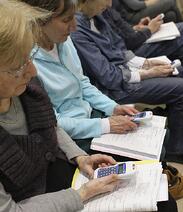
Paper or manually counted ballots to elect multiple persons to a position or board can be cumbersome and time consuming. This is particularly true when individuals are required to achieve a plurality of the votes cast (greater than 50%) in order to be elected. Often this means multiple ballots to fill the open positions.
Electronic voting technology can take away the pain associated with this ballots to elect multiple individuals simultaneously. Each voter uses a handheld wireless voting device to make their selections and results are tabulated immediately. Typically this involves a Turnkey Rental solution with equipment and on-site personnel to operate the system and work with your organization and ensure that the balloting process runs smoothly.
Multi-candidate/Multi-pass elections can be complex. Here is an example: An organization is electing three individuals to the office of vice president, with fifteen candidates in the running. The candidates with the most votes will be elected but candidates must receive a vote of 50% plus 1 of the votes cast (a plurality). For the purposes of this example, we will assume 1,000 people are voting. On the first ballot, candidate Jane Smith receives 592 votes. She received the most votes of the 15 candidates. Jane is elected. Marsha Ortiz received 419 votes. She received the second highest number of votes of the 15 candidates, but is not elected because she did not reach a plurality of 501 votes (50% plus 1 of the 1,000 votes cast.)
A second ballot is conducted. On this ballot, the name of Jane Smith is removed from the list of candidates. Voters are given one selection from a list of 14 nominees. On the second ballot, Marsha Ortiz receives 609 votes and is elected since she has exceeded the required threshold of 501 votes.
This type of election process requires advanced OptionFinder G4 keypads or Virtual Participant web polling devices. These systems enable voters to enter multiple digit numbers (usually three or four digits) that represent their candidate choice. OTI often provides a worksheet for voters to write down their selections on each ballot to prevent confusion during the voting process. In some cases, there are hundreds of candidates, so this worksheet is a helpful tool. The OptionPower system can support up to 9,999 candidates.
OTI will consult with your organization in advance regarding the details of your voting process, procedures and rules to ensure that your meeting will be a success. We can also produce instructional video sample scripts for your presiding officers and instruction sheets to be passed out to voters. Upon arrival at the voting session, delegates are given an opportunity to vote in a practice voting session to reduce confusion and confirm that they are comfortable with the technology. Option Technologies typically provides an electronic voting help desk in the meeting room to answer any questions or concerns from voters as well as troubleshoot any OptionFinder keypads that are not working properly. On all rental projects, OptionFinder keypads are tested every day to make sure that voters receive a device that is fully functional.
The OptionFinder G3 keypad has a messaging function that will enable voters to confirm their selection by showing the name of the candidate they select on the screen. Keypads may also be used to vote on issues other than electing candidates. They can be used to vote “yes”, “no” and “abstain” with different approval thresholds. There is also an on-screen pass/fail indicator available that can be configured to match the required quantum threshold for passage of a motion or ballot initiative (majority, 2/3rd’s, ¾’s, etc.)
Electronic voting on will improve the speed and efficiency of your meeting and increase Return on Investment. We understand that delegate events require significant time and money. OTI technology helps to speed up this process and cut down balloting time by as much as 70-80%. With the average person’s time is worth at least $10 per hour an event of 500 attendees, we can generate a return on investment of $2,500 per ballot in time saved.


